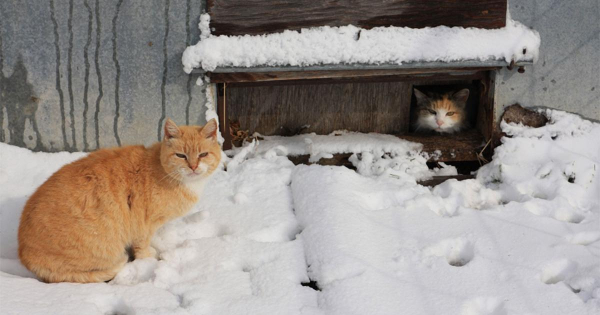Suche
Beiträge, die mit DairyCows getaggt sind
#Cat Death Losses Due to Highly Pathogenic Avian Influenza in #SouthDakota
Updated January 13, 2025
"#Veterinarians and laboratory diagnosticians are fielding reports of death losses in cat populations linked to avian influenza infections.
"Beginning in 2022, an #H5N1 subtype of highly pathogenic avian influenza (abbreviated as HPAI) virus caused death losses in domestic turkeys and chickens in South Dakota and elsewhere in the United States, an outbreak that continues. The HPAI virus causes respiratory and multiple organ failure in affected birds, typically appearing as increased numbers of dead birds in large commercial operations, as well as smaller backyard flocks. Deaths in wild birds, typically migrating waterfowl but also other bird species, have been observed at the same time, as well as spillover of the virus into mammals, such as raccoons, foxes, skunks, and other species.
"In Spring 2024, the HPAI virus began infecting #DairyCows, causing drops in milk production and other signs of illness. Unlike infections in other species, widespread death losses have not been associated with HPAI infections in dairy cows.
"About the same time as its emergence in dairy cows, the HPAI virus was implicated in deaths of domestic cats in the vicinity of affected farms. Most affected cats showed #neurologic signs, such as #tremors or #seizures, for a short period of time before dying.
"Since that time, three cases of substantial death losses in groups of outdoor domestic cats in South Dakota have been described. In each of these cases, there has been no apparent link to dairy cows, other livestock, or domestic poultry."
Read more:
https://extension.sdstate.edu/cat-death-losses-due-highly-pathogenic-avian-influenza-south-dakota
#HPAINews #HPAI #AvianInfluenza #BirdFlu #USHealth #CDCCensorship
Updated January 13, 2025
"#Veterinarians and laboratory diagnosticians are fielding reports of death losses in cat populations linked to avian influenza infections.
"Beginning in 2022, an #H5N1 subtype of highly pathogenic avian influenza (abbreviated as HPAI) virus caused death losses in domestic turkeys and chickens in South Dakota and elsewhere in the United States, an outbreak that continues. The HPAI virus causes respiratory and multiple organ failure in affected birds, typically appearing as increased numbers of dead birds in large commercial operations, as well as smaller backyard flocks. Deaths in wild birds, typically migrating waterfowl but also other bird species, have been observed at the same time, as well as spillover of the virus into mammals, such as raccoons, foxes, skunks, and other species.
"In Spring 2024, the HPAI virus began infecting #DairyCows, causing drops in milk production and other signs of illness. Unlike infections in other species, widespread death losses have not been associated with HPAI infections in dairy cows.
"About the same time as its emergence in dairy cows, the HPAI virus was implicated in deaths of domestic cats in the vicinity of affected farms. Most affected cats showed #neurologic signs, such as #tremors or #seizures, for a short period of time before dying.
"Since that time, three cases of substantial death losses in groups of outdoor domestic cats in South Dakota have been described. In each of these cases, there has been no apparent link to dairy cows, other livestock, or domestic poultry."
Read more:
https://extension.sdstate.edu/cat-death-losses-due-highly-pathogenic-avian-influenza-south-dakota
#HPAINews #HPAI #AvianInfluenza #BirdFlu #USHealth #CDCCensorship

Cat Death Losses Due to Highly Pathogenic Avian Influenza in South Dakota
Veterinarians and laboratory diagnosticians are fielding reports of death losses in cat populations linked to avian influenza infections.SDSU Extension
Time is of the essence: #effectiveness of dairy #farm #control of #H5N1 is limited by fast spread
Source: BioRxIV, https://www.biorxiv.org/content/10.1101/2024.11.15.623774v1?rss=1
Abstract
The emergence and growth of highly pathogenic avian influenza(HPAI) A(H5N1) in dairy cows poses a growing threat for both the food supply and onward zoonosis to humans. Despite ongoing surveillance and control measures recommended by animal and public health authorities to limit viral spread, new herds continue to report infections. We show here that the continued spread between farms could be explained by the rapid pace of pathogen spread reported within farms, which greatly limits the potential effectiveness of these recommendations. Under reasonable surveillance strategies, we show that the time farms have to mobilize interventions is extremely limited, as few as a couple days and typically less than a week. Our findings suggest that passive surveillance measures, such as detection of H5N1 via weekly bulk milk testing, comes too late such that most infections have already occurred. For current interventions to be valuable, more sensitive and extensive surveillance is needed and an emphasis should be placed on biosecurity practices rather than reactive practices.
____
#abstract #avianInfluenza #AVIANINFLUENZA #birdFlu #dairyCows #h5n1 #health #news #research #USA
